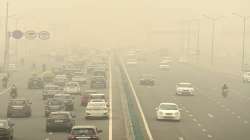Delhi: Air pollution triggers health concerns as AQI remains in ‘severe’ category
Delhi has been witnessing a thick layer of toxic cover for nearly five days. The air quality remained in the 'severe' category even on Saturday morning, which has triggered health concerns for the younger and elderly.

Delhi AQI: Air pollution levels in the national capital region declined slightly overnight on Saturday (November 4), thanks to relatively better wind speed, however, the current situation continues to be alarming with the concentration of poisonous PM2.5 still being over 80 times the healthy limit prescribed by the World Health Organization. The air quality in the national capital remained in the ‘Severe’ category with an overall AQI of 416. A thick toxic haze surrounded the city as the residents woke up to yet another filthy air for the fifth day straight.
The doctors have expressed their concerns regarding an increase in the respiratory and eye problems among the young and the elderly.
The city's minimum temperature settled at 16.6 degrees Celsius, according to officials.
The AQI at Shadipur was recorded at 453. It was 448 at Anand Vihar, 435 at Punjabi Bagh, 432 at Okhla and 431 at RK Puram, according to the Central Pollution Control Board (CPCB).
The air quality in other parts of the NCR was also similar to Delhi with Ghaziabad recording AQI at 377, Greater Noida at 490, Faridabad at 449 and Gurugram at 392, according to CPCB.
An AQI between zero and 50 is considered "good", 51 and 100 "satisfactory", 101 and 200 "moderate", 201 and 300 "poor", 301 and 400 "very poor", and 401 and 500 "severe".
Contributing factors to pollution
The concentration of PM2.5, fine particulate matter capable of penetrating deep into the respiratory system and triggering health problems, exceeded the government-prescribed safe limit of 60 micrograms per cubic metre by seven to eight times at multiple locations throughout Delhi-NCR. It was 80 to 100 times the healthy limit (5 micrograms per cubic metre) set by the WHO.
The air quality in Delhi-NCR dipped significantly due to a surge in stubble burning across neighbouring states Punjab and Haryana, besides which a gradual drop in temperatures, calm winds that trap pollution have also played a contributing factor.
According to the Central Pollution Control Board (CPCB) data, Delhi’s AQI witnessed a sharp spike by over 200 points between October 27 and November 3, and ended in a descent into the ‘severe plus’ category (above 450) on Friday.
However, the AQI marginally improved from 468 at 4 pm on Friday to 413 at 6 am on Saturday. Friday's 24-hour average AQI (468) was the worst since the previous high of 471 recorded on November 12, 2021.
Delhi’s air quality among worst in world’s capitals
Delhi’s air quality ranks among the worst in the world's capital cities. According to a report by the Energy Policy Institute at the University of Chicago (EPIC) in August, air pollution in Delhi shortens the lives by nearly 12 years.
Delhi-NCR witnesses dipped air quality every year during the winter due to stubble burning, emissions from vehicles, unfavourable meteorological conditions and other local pollution sources.
(With PTI inputs)